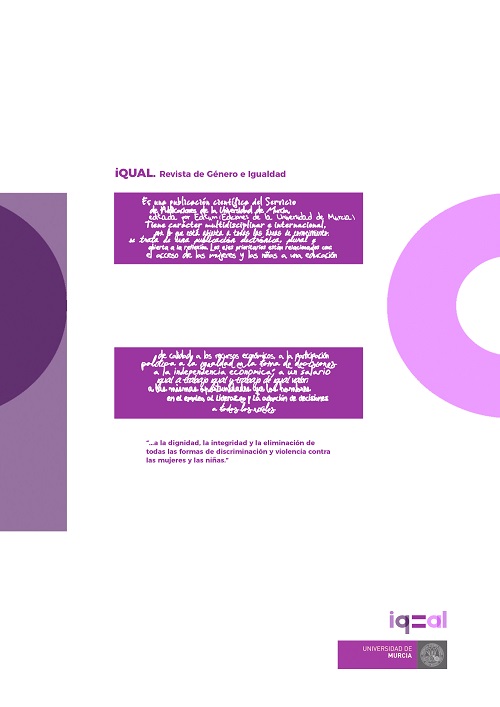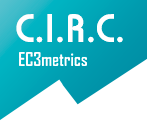La publicación en Estudios de Género en el último lustro. Un análisis cienciométrico.
Agencias de apoyo
- Proyecto de Investigación referencia PGC2018-098813-B-C32. Ministerio de Ciencia, Innovación y Universidades.
Resumen
Los Estudios de Género constituyen una categoría propia dentro del corpus académico desde hace ya décadas, incrementándose su producción cada año desde sus inicios. Los miles de documentos científicos que la conforman hace que sea complejo tener una idea general de las tendencias en este ámbito de investigación. El minado de textos ha permitido hacer un análisis cienciométrico a partir de 23.635 artículos correspondientes a la categoría “Gender Studies” de la base de datos Scopus, abarcando el periodo 2017-2021. El estudio automatizado ha permitido obtener una serie de conclusiones de interés que en este trabajo se presentan. El presente trabajo concluye la importancia de la implementación de políticas activas de género por los gobiernos, pues esto se traduce en investigación científica (teórica y práctica) que analiza las causas y propone soluciones a la desigualdad de género de forma transversal en todos los aspectos de la vida.
Descargas
-
Resumen610
-
PDF573
Citas
Agüero, J. M. (2021). COVID-19 and the rise of intimate partner violence. World development, 137, 105217.
Alon, T., Doepke, M., Olmstead-Rumsey, J., & Tertilt, M. (2020). The impact of COVID-19 on gender equality. Tech. rep., National Bureau of economic research.
Baas, J., Schotten, M., Plume, A., Côté, G., & Karimi, R. (2020). Scopus as a curated, high-quality bibliometric data source for academic research in quantitative science studies. Quantitative Science Studies, 1, 377–386.
Bartz, D., Chitnis, T., Kaiser, U. B., Rich-Edwards, J. W., Rexrode, K. M., Pennell, P. B., others. (2020). Clinical advances in sex-and gender-informed medicine to improve the health of all: a review. JAMA internal medicine, 180, 574–583.
Brickell, C. (2006). The sociological construction of gender and sexuality. The Sociological Review, 54, 87–113.
Broadus, R. N. (1987). Toward a definition of “bibliometrics”. Scientometrics, 12, 373–379.
Chellappandi, P., & Vijayakumar, C. S. (2018). Bibliometrics, Scientometrics, Webometrics/Cybermetrics, Informetrics and Altmetrics–An Emerging Field in Library and Information Science Research. Shanlax International Journal of Education, 7, 5–8.
Collins, C., Landivar, L. C., Ruppanner, L., & Scarborough, W. J. (2021). COVID-19 and the gender gap in work hours. Gender, Work & Organization, 28, 101–112.
Ferguson, M. L. (2017). Neoliberal feminism as political ideology: revitalizing the study of feminist political ideologies. Journal of political ideologies, 22, 221–235.
Gebhard, C., Regitz-Zagrosek, V., Neuhauser, H. K., Morgan, R., & Klein, S. L. (2020). Impact of sex and gender on COVID-19 outcomes in Europe. Biology of sex differences, 11, 1–13.
Gottschall, M. (2002). The ethical implications of the deconstruction of gender. Journal of the American Academy of Religion, 70, 279–299.
Graf, N., Brown, A., & Patten, E. (2018). The narrowing, but persistent, gender gap in pay. Pew Research Center, 9.
Grumbach, J. M., Sahn, A., & Staszak, S. (2020). Gender, race, and intersectionality in campaign finance. Political Behavior, 1–22.
Guzman, J., & Kacperczyk, A. O. (2019). Gender gap in entrepreneurship. Research Policy, 48, 1666–1680.
Halevi, G., Moed, H., & Bar-Ilan, J. (2017). Suitability of Google Scholar as a source of scientific information and as a source of data for scientific evaluation—Review of the literature. Journal of informetrics, 11, 823–834.
Harris, A., & Leonardo, Z. (2018). Intersectionality, race-gender subordination, and education. Review of Research in Education, 42, 1–27.
Harzing, A.-W., & Alakangas, S. (2016). Google Scholar, Scopus and the Web of Science: a longitudinal and cross-disciplinary comparison. Scientometrics, 106, 787–804.
Higgins, C. (2018). The age of patriarchy: How an unfashionable idea became a rallying cry for feminism today. The Guardian, 22.
Johnson, O. W., Han, J. Y.-C., Knight, A.-L., Mortensen, S., Aung, M. T., Boyland, M., & Resurrección, B. P. (2020). Intersectionality and energy transitions: A review of gender, social equity and low-carbon energy. Energy Research & Social Science, 70, 101774.
Kantola, J., & Lombardo, E. (2019). Populism and feminist politics: The cases of Finland and Spain. European Journal of Political Research, 58, 1108–1128.
Kessler, M. M. (1963). Bibliographic coupling between scientific papers. American documentation, 14, 10–25.
Laskey, P., Bates, E. A., & Taylor, J. C. (2019). A systematic literature review of intimate partner violence victimisation: An inclusive review across gender and sexuality. Aggression and Violent Behavior, 47, 1–11.
Li, K., Rollins, J., & Yan, E. (2018). Web of Science use in published research and review papers 1997–2017: A selective, dynamic, cross-domain, content-based analysis. Scientometrics, 115, 1–20.
Lipson, S. K., Raifman, J., Abelson, S., & Reisner, S. L. (2019). Gender minority mental health in the US: results of a national survey on college campuses. American journal of preventive medicine, 57, 293–301.
López-Huertas, M. J. (2006). Thematic map of interdisciplinary domains based on their terminological representation. The Gender Studies. Knowledge Organization for a Global Learning Society. Proceedings of the Ninth International ISKO Conference, 331–338.
Matsick, J. L., & Rubin, J. D. (2018). Bisexual prejudice among lesbian and gay people: Examining the roles of gender and perceived sexual orientation. Psychology of Sexual Orientation and Gender Diversity, 5, 143.
McCann, H. (2019). Queer theory now: From foundations to futures. Red Globe Press.
Mendes, K., Ringrose, J., & Keller, J. (2018). # MeToo and the promise and pitfalls of challenging rape culture through digital feminist activism. European Journal of Women's Studies, 25, 236–246.
Orduña Malea, E., Martı́n-Martı́n, A., & Delgado-López-Cózar, E. (2017). Google Scholar as a source for scholarly evaluation: a bibliographic review of database errors. Revista española de documentación cientı́fica, 40, 1–33.
Parent, M. C., DeBlaere, C., & Moradi, B. (2013). Approaches to research on intersectionality: Perspectives on gender, LGBT, and racial/ethnic identities. Sex roles, 68, 639–645.
Podsakoff, P. M., MacKenzie, S. B., Podsakoff, N. P., & Bachrach, D. G. (2008). Scholarly influence in the field of management: A bibliometric analysis of the determinants of university and author impact in the management literature in the past quarter century. Journal of Management, 34, 641–720.
Reichelt, M., Makovi, K., & Sargsyan, A. (2021). The impact of COVID-19 on gender inequality in the labor market and gender-role attitudes. European Societies, 23, S228–S245.
Reinking, A., & Martin, B. (2018). The gender gap in STEM fields: Theories, movements, and ideas to engage girls in STEM.
Rodriguez-Rodriguez, I., & Heras-González, P. (2020). A Study of the Protocols for Action on Sexual Harassment in Public Universities—Proposals for Improvement. Social Sciences, 9, 128.
Shaw, L. J., Pepine, C. J., Xie, J., Mehta, P. K., Morris, A. A., Dickert, N. W., . . . others. (2017). Quality and equitable health care gaps for women: attributions to sex differences in cardiovascular medicine. Journal of the American College of Cardiology, 70, 373–388.
Small, H. (1973). Co-citation in the scientific literature: A new measure of the relationship between two documents. Journal of the American Society for information Science, 24, 265–269.
Song, M., & Ding, Y. (2014). Topic modeling: Measuring scholarly impact using a topical lens. En Measuring scholarly impact, 235–257. Springer.
Stoet, G., & Geary, D. C. (2018). The gender-equality paradox in science, technology, engineering, and mathematics education. Psychological science, 29, 581–593.
Taylor, V., & Rupp, L. J. (1993). Women's culture and lesbian feminist activism: A reconsideration of cultural feminism. Signs: Journal of Women in Culture and Society, 19, 32–61.
Thongpapanl, N. T. (2012). The changing landscape of technology and innovation management: An updated ranking of journals in the field. Technovation, 32, 257–271.
Valderrama-Zurián, J.-C., Aguilar-Moya, R., Melero-Fuentes, D., & Aleixandre-Benavent, R. (2015). A systematic analysis of duplicate records in Scopus. Journal of Informetrics, 9, 570–576.
Van Eck, N. J., & Waltman, L. (2007). VOS: A new method for visualizing similarities between objects. En Advances in data analysis (págs. 299–306). Springer.
Van Eck, N., & Waltman, L. (2011). Text mining and visualization using VOSviewer. arXiv preprint arXiv:1109.2058.
van Eck, N., Waltman, L., Noyons, E., & Buter, R. (2010). Automatic term identification for bibliometric mapping. Scientometrics, 82, 581–596.
Visser, M., van Eck, N. J., & Waltman, L. (2021). Large-scale comparison of bibliographic data sources: Scopus, Web of Science, Dimensions, Crossref, and Microsoft Academic. Quantitative Science Studies, 2, 20–41.
Woodward, K. (2014). Social sciences: the big issues. Routledge.
Yan, E., Ding, Y., & Jacob, E. K. (2012). Overlaying communities and topics: An analysis on publication networks. Scientometrics, 90, 499–513.
Zhu, J., & Liu, W. (2020). A tale of two databases: The use of Web of Science and Scopus in academic papers. arXiv preprint arXiv:2002.02608.
Derechos de autor 2022 Servicio de Publicaciones Universidad de Murcia

Esta obra está bajo una licencia internacional Creative Commons Atribución-NoComercial 4.0.








